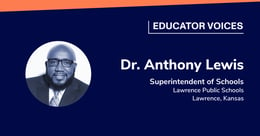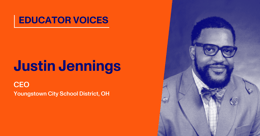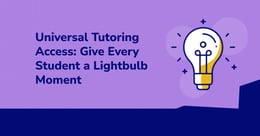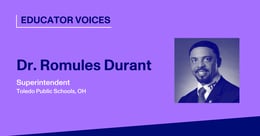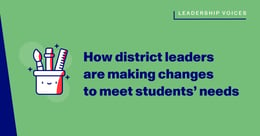
Riverside's Approach to Unified & Remote Learning
“You’re going to get kids to engage because of teachers—not because of a policy, not because of a rule. They’re going to want to show up for their teachers,” said Ryan Lewis, Assistant Superintendent of Curriculum and Instruction at Riverside Unified School District (RUSD).
California’s sixteenth largest school district, RUSD contains thirty schools, eight of which are dual-language schools. On March 13, when schools were ordered to close by the end of the day, RUSD had already begun planning ways of enhancing socially-distanced education and distributing devices for remote learning.
The Paper Team recently interviewed members of the RUSD leadership team: Dr. Jamie Angulo, Dr. Ryan Lewis, and Tim Walker. We also received input from RUSD Superintendent Dr. David Hansen and Board President Kathy Allavie, post-interview.
Superintendent Dr. David Hansen said,
Although we are living through a truly historic and unprecedented moment, we remain committed to our mission to provide engaging, innovative, and equitable learning experiences for all students. We will continue to pivot to ensure all our families are getting the best education possible.
Reaction and adaptation
As school moved out of a physical building, Tim Walker, Assistant Superintendent, Pupil Services and Special Education, says that communication drastically increased. RUSD began holding daily debriefing meetings with the leaders of the district. These meetings focused on the accessibility and efficacy of remote learning and other initiatives, including meal distribution at fifteen locations (set to continue throughout the summer), family webinars for social, psychological, emotional well-being, and “Hop Cast,” podcasts featuring elementary school students.
The vision statement of RUSD instruction is to “expand use of and access to technology in order to increase the availability of resources and teaching and learning options for students, teachers, and the community,” and they have done just that.
Prioritizing equity
Riverside stands out as the leaders of responding to the crisis while prioritizing equity - not only for their students but also for staff members and parents in the district.
RUSD has an Equity Task Force, where leaders from the community and school system come together in weekly Zoom meetings to tackle equity concerns and training related to equity. The African American Parent Committee and Special Education groups have continued through the COVID-19 crisis, and specialized supports are available while learning continues remotely. Their student assistance program was created in order to support both students and staff members (in collaboration with psychologists and counselors). This program continues in the new, virtual world.
RUSD Board President, Kathy Allavie, shared “Through student surveys and various advisory committees, we get regular feedback from our community to guide policy and decision making around distance learning. It is more crucial than ever for curriculum to be nimble; to offer different learning solutions for all of our families.”
Riverside is taking into account the district’s large poverty divide within their student body, and that this discrepancy is something that is being closely monitored and actively supported. RUSD’s administrators acknowledge that every family situation is different, so by supplying the tools, technologies, and interpersonal support, they were hoping to increase access and engagement during this crisis – and they have been successful.
They have already loaned out 16,000 computers and provided free internet services and hotspots to students who require support. Flexible learning options have become an integral part of remote learning; for example, if students are unable to attend a virtual class in real-time because they’re taking care of siblings, lessons are recorded, giving students the ability to catch up in their own time.
Tim Walker emphasizes that virtual learning is not an all-inclusive solution to education in the long-term, especially for students with moderate and severe disabilities. The growth of these students is dependent on being in close contact with their peers, teachers, nurses, and psychologists, so he stresses that extra attention will be required on students with disabilities when they do return.
RUSD reports that an impressive 80% of their student body is engaged, and for the 20% that are not engaged, RUSD is directing their outreach committee towards these students over the summer - offering devices, online resources, internet services, etc. Although summer programs will be ending the first week of July, devices will be left with students until then (there will be some collection of devices after July, but this is dependent on what the back to school model looks like for the Fall, which is now looking like a hybrid of in-person and distance learning.
One unique initiative that RUSD has included in their response to COVID-19 is regularly meeting with a student advisory committee. The Superintendent and Board President meet with Senior student leaders from every single high school (elected officials, class officers, class presidents) to help make decisions, including drive-thru graduations.
Looking forward
What does the Fall look like?
Kathy Allavie said,
Things are changing almost every day, and we will adapt in order to be a resource to our students and community. There may have to be in-school and out-of-school models, but we will accommodate our children as best we can.
RUSD is taking this crisis as an opportunity to re-draw the blueprints for public education – something that can rarely be done in public education. This crisis has demanded professional development opportunities for educators. Teachers are adapting to new ways of teaching, educators are seeing that students can learn in different ways, and administrators are experiencing that they can hold meetings differently.
Evidently, budgeting from the state is a factor in re-imagining the future. So far, the guiding question for RUSD has been how they can accommodate the largest percentage of students with the resources available.
Going forward, schools will likely see more of this “Virtual Academy” approach, however, parents will also have more choice than ever before – especially when it comes to sending students back versus keeping them at home. Parents are learning just how important teachers are; Jamie Angulo, Director of Instructional Services 7-12, says that teachers have truly gone above and beyond to connect with students during these times. For instance, students were appreciative that at cap and gown distributions for seniors, teachers hosted signs and played music while following social distancing protocols.

